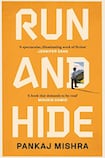
Pankaj Mishra’s second novel is a psychodrama of social mobility. Run and Hide tells the story of three talented young Indian men from provincial, lower middle-class backgrounds who slog their guts out to get into a prestigious mechanical engineering college in Delhi, and rise up the social ladder.
Rapacious go-getters Aseem and Virendra strike it rich and enjoy a champagne lifestyle as self-styled cultural impresarios. Arun, a more sensitive sort, ekes out a modest living as a translator but has one foot in the elite milieu courtesy of his girlfriend, Alia, a wealthy heiress and high-profile feminist activist based in London. Arun feels profoundly ill at ease in her world, unable to shake “the feeling that I was performing in a troupe with better actors”.
Run and Hide is narrated in the second person, in the form of a long and emotionally candid letter from Arun to Alia. We begin at the end, knowing only that things have gone awry between the couple, and that Arun’s pals have calamitously fallen from grace. He reflects ruefully on their misadventures and ponders the “the peculiar panic and incoherence of self-made men; how they spend their lives fearing breakdown and exposure”.
In Aseem’s case, the parvenu inferiority complex manifests itself libidinally: he brags about having had “ten thousand f**ks”, and has a particular fondness for blonde Russian sex workers. In Arun, it manifests in gnawing self-doubt and existential restlessness – the compulsion to flee that gives the book its title.
In the 20-odd years since the publication of his debut novel, The Romantics (1999), Mishra has built a reputation as an incisive political polemicist, with books such as Age of Anger (2017) and Bland Fanatics (2020) and occasional essays in the London Review of Books. The concerns that animate his nonfiction writing – political economy, geopolitics and class – are very much to the fore here, as his protagonists meditate on matters such as the decline of US hegemony, China’s economic ascendency and the sectarian violence stoked by the Hindu nationalist rhetoric of India’s prime minister, Narendra Modi.
Echoing August Babel’s famous line about anti-Semitism being the socialism of fools, Arun wonders whether Modi’s anti-Muslim chauvinism is merely a warped class resentment writ large: he “had given the lowest of the low-born a rare chance at social mobility, and they eagerly took it”.
Mishra might have done well to rein in this editorialising tendency, as a bit too much of the novel is taken up with elucidating its gist. Aseem rather steals my thunder when he remarks that “The lower middle-class is the true maker of history . . . it’s people like us . . . who make and remake the world with our hunger and ambition”. I had wanted to say that in this review. Ditto Arun when he points out that the figure of the ambitious thruster is well represented in the literary canon, as novelists such as Balzac, Stendhal and Flaubert had written about “people from nowhere, compelled to create a place for themselves”. I had wanted to say that, too.
There are some pleasing lines here and there: a mealtime standoff is “A silence of suspended munching”; noisy outbound trains “take their bad temper to the countryside”. In places the prose style is a tad mannered: people don’t wash but perform “ablutions”; things are “espied” rather than noticed.
Mishra’s narrator is prone to occasional clunky locutions – remarking, for example, that a truthful account of events “was no sin against verisimilitude”. This lends a stilted texture to the prose, though it’s arguably a plausible rendering of the hypercorrect diction cultivated by certain aspiring types who are trying too a little hard to sound the part.
The novel’s engagement with masculinity is somewhat limp: the two main male characters, Arun and Aseem, are respectively a passive dweeb and a hyper-assertive sleaze, which is too neat and binary. Mishra is more convincing when he explores the psychic baggage of deracination and the toxicity of obsessive ambition, with its “continual wanting” sustained by “faith in a future windfall”. Beset with imposter syndrome and homesickness, and finding little consolation in an unequal romantic relationship (“To be with you was to be alone in a different way”), Arun’s predicament will be familiar to anyone who has moved between social strata.
Ours is a world built on the ideology of aspiration, but human beings also crave other things besides status: security, dignity, a sense of belonging. For the atomised striver, compelled to forgo these needs, the world is a lonely place indeed.









